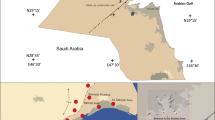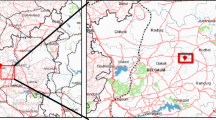Abstract
Karanpura field is the western most member of the E-W trending Damodar Valley basin, belonging to Indian Gondwana sedimentation. This paper aims to provide a field-scale depositional model of Permian Barakar Formation from Karanpura field in order to enlarge the knowledge of stratigraphic and facies architecture. The study reviews the findings from extensively available cores. Four major facies were defined, which represented a fluvial depositional environment. Observations from core analyses were integrated with high resolution geophysical log data to understand the stacking pattern and depositional cyclicity of Barakar Formation. The lateral and vertical distributions of the facies associations were highlighted by well correlations, which established major fining upwards depositional cycles in the area. The depositional model has been interpreted on a regional scale.
Similar content being viewed by others
References
Allen, J.R.L. (1970) Studies in fluviatile sedimentation: a comparison of fining-upwards cyclothems with special reference to coarse-member composition and interpretation. Jour. Sediment. Petrol., v.40, pp.298–323.
Bhattacharya, B., Bandyopadhyay, S., Mahapatra, S., Banerjee, S. (2012) Record of tide-wave influence on the coal-bearing Permian Barakar Formation, Raniganj Basin, India. Sediment. Geol., v.267–268, pp.25–35.
Biswas, S.K. (1999) A review on the evolution of rift basins in India during Gondwana with special reference to Western Indian Basins and their hydrocarbon prospects. PINSA, v.65, pp.261–283.
Bridge, J.S. (1984) Large-scale facies sequences in alluvial overbank environments. Jour. Sediment. Petrol., v.54, pp.583–588.
Bridge, J.S. (1993) Description and interpretation of fluvial deposits: a critical perspective. Sedimentology, v.40, pp.801–810.
Bridge, J.S. and Tye, R.S. (2000) Interpreting the dimensions of ancient fluvial channel bars, channels, and channel belts from wireline-logs and cores. AAPG Bull., v.84, pp.1205–1228.
Cant, D.J. and Walker, R.G. (1976) Development of a braided fluvial facies model for the Devonian Battery Point Sandstone, Quebec. Canadian Jour. Earth Sci., v.13, pp.102–119.
Casshyap, S.M. (1970) Sedimentary cycles and environment of deposition of the Barakar coal measures of Lower Gondwana, India. Jour. Sediment. Petrol., v.40, pp.283–303.
Casshyap, S.M. and Kumar, A. (1987) Fluvial Architecture of the Upper Permian Raniganj Coal Measure in the Damodar Basin, Eastern India. Sediment. Geol., v.51, pp.181–213.
Casshyap, S.M. and Tewari, R.C. (1984) Fluvial models of the Lower Permian Gondwana coal measures of Son- Mahanadi and Koel-Damodar basins. In: Rahmani, R.A. and Flores, R.M. (Eds.), Sedimentology of coal and coal bearing strata. Spec. Publ., Intl. Assoc. Sediment., v.7, pp.121–147.
Casshyap, S.M. and Tewari, R.C. (1987) Depositional model and tectonic evolution of Gondwana basins. Palaeobotanist, v.36, pp.59–66.
Casshyap, S.M. and Tewari, R.C. (2001) Lithofacies and sedimentation of Mid-Permian Lower Gondwana red beds of eastern Peninsular India. Contributions to Geology and Palaeontology of Gondwana in Honour of Helmut Wopfner, pp.63–72.
Dey, J., Sen, S. and Bhattacharjee, S. (2018) Geophysical Log-based Coal Characterization of Middle Permian Barakar Formation from North Karanpura Coal Field, India. Jour. Geol. Soc. India, v.92, pp.36–44.
Dey, J. and Sen, S. (2018) Sequence Stratigraphic Model of Middle Permian Barakar Formation from a Marginal Gondwana Basin, India. Jour. Earth Sci., v.29(4), pp.745–754.
Galloway, W.E. and Hobday, D.K. (1996) Terrigenous clastic depositional systems, Application to fossil fuel and groundwater resources. Springer-Verlag, Berlin, 489p.
Gupta, A. (1999) Early Permian Palaeoenvironment in Damodar Valley Coalfield, India: an Overview. Gondwana Res., v.2(2), pp. 149–165.
Hota, R.N. (2010) Coal Correlation and Intrabasinal Differential Subsidence - A Case Study from the Barakar Formation of Talchir Gondwana Basin, Orissa. Jour. Geol. Soc. India, v.75, pp.403–410.
Kumar, A., Singh, A.K., Singh, Prakash K., Singh, Asha Lata, Jha, M.K. (2018) Demineralization study of high ash Permian coal with Pseudomonas mendocina strain B6-1: A case study of South Karanpura coalfield, Jharkhand, India. Energy & Fuels, v.32, pp.1080–1086.
Mendhe, V.M., Kamble, A.D., Banerjee, M., Mishra, S., Mukherjee, S., Mishra, P. (2016) Evaluation of Shale Gas Reservoir in Barakar and Barren Measures Formations of North and South Karanpura Coalfields. Jour. Geol. Soc. India, v.88, pp.305–316.
Mukhopadhyay, G., Mukhopadhyay, S.K., Roychowdhury, M., Parui, P.K. (2010) Stratigraphic Correlation between Different Gondwana Basins of India. Jour. Geol. Soc. India, v.76, pp.251–266.
Opluštil, S., Martínek, K., Tasáryová, Z. (2005) Facies and architectural analysis of fluvial deposits of the Nýøany Member and the Týnec Formation (Westphalian D - Barruelian) in the Kladno-Rakovník and Pilsen basins. Bull. Geosci., v.80(1), pp.45–66.
Pettijohn, F.J. (1957) Paleocurrents of Lake Superior Precambrian quartzite. Bull. Geol. Soc. Amer., v.68, pp.469–480.
Pettijohn, F.J. (1975) Sedimentary Rocks, Harper and Row, New York, N.Y., 3rd ed., 628p.
Priyadarshi, N. (2004) Distribution of arsenic in Permian Coals if North Karanpura coalfield, Jharkhand. Jour. Geol. Soc. India, v.63(5), pp.533–536.
Rust, B.R. (1972) Structure and process in a braided river. Sedimentology, v.18, pp.221–246.
Singh, M.P., Singh, P.K., Singh, A.K. (2003) Petrography and Depositional environments of the Permian Coal Deposits of Deoghar Basins, Bihar. Jour. Geol. Soc. India, v.61(4), pp.419–438.
Singh, M.P. and Singh, P.K. (1996) Petrographic characterization and evolution of the Permian coal deposits of the Rajmahal basin, Bihar, India. International Jour. Coal Geol., Elsevier, The Netherlands. v.29, pp.93–118.
Sen, S. and Banerjee, S. (2015) Identifying relationship amongst Vitrinite/Inertinite ratio (V/I), Cleat parameters, Vitrinite Reflectance, O/C ratio and Permeability of coal seams & V/I as exploration tool - Study from Raniganj Coal bed Methane block of Essar Oil Limited, in Petroleum Geosciences: Indian Context, Springer Geology, pp.205–217.
Sen, S. (2015) Review on coal petrographic indices and their applicability in paleoenvironmental interpretation. Geosciences Jour., v.20(5), pp.719–729.
Sen, S., Das, N. and Maiti, D. (2016) Facies Analysis and Depositional Model of Late Permian Raniganj Formation: Study from Raniganj Coal Bed Methane Block. Jour. Geol. Soc. India, v.88, pp.503–516.
Sen, S., Naskar, S. and Das, S. (2016) Discussion on the concepts in palaeoenvironmental reconstruction from coal macerals and petrographic indices. Marine and Petroleum Geology, v.73, pp.371–391.
Sen, S. and Dey, J. (2018) Analysis of sedimentary architectures and depositional environment using core and geophysical logs - A case study from a marginal Gondwana basin, eastern India, in 3rd FOSI-IAS-SEPM Regional Seminar: Past & Present Sedimentation in Tropical Region, Yogyakarta, Indonesia, Sept 5–6, 2018.
Tewari, R.C. (2005) Tectonic-stratigraphic-sedimentary events in Gondwana succession of Peninsular India. Jour. Geol. Soc. India, v.65, pp.636–638.
Tewari, R.C. and Maejima, W. (2010) Origin of Gondwana basins of Peninsular India. Jour. Geosci., v.53, pp.43–49 (Osaka City University).
Tye, R.S. (1991) Fluvial-sandstone reservoirs of the Travis Peak Formation, East Texas Basin. In: Miall, A.D. and Tyler, N. (Eds.), The Three-Dimensional Facies Architecture of Terrigenous Clastic Sediments and Its Implications for Hydrocarbon Discovery and Recovery. SEPM Concepts in Sedimentology and Paleontology, v.3, pp.172–188.
Acknowledgement
Authors express their sincere gratitude to Dr. Prakash Kumar Singh, Associate Editor, Journal of the Geological Society of India for his timely communication and valuable suggestions. Authors are grateful to the two reviewers for their detailed review and suggestions, which improved the manuscript. JD is thankful to his previous employer Coal India Limited. SS thanks his employer Geologix Limited for giving the access of Coal characterization, XSection modules of GEO Suite of software, which were instrumental in correlations and various geophysical log based analyses. This work has only used all the previously published works (and dataset) that JD and SS did and aimed to summarize their previous findings here but with a focus on the depositional environment of Gondwana basin.
Author information
Authors and Affiliations
Corresponding author
Rights and permissions
About this article
Cite this article
Sen, S., Dey, J. A Field-scale Overview of Facies Architectures and Depositional Environment Integrating Core and Geophysical Log Data: Study from a Marginal Gondwana Basin, India. J Geol Soc India 94, 238–244 (2019). https://doi.org/10.1007/s12594-019-1302-x
Received:
Accepted:
Published:
Issue Date:
DOI: https://doi.org/10.1007/s12594-019-1302-x




